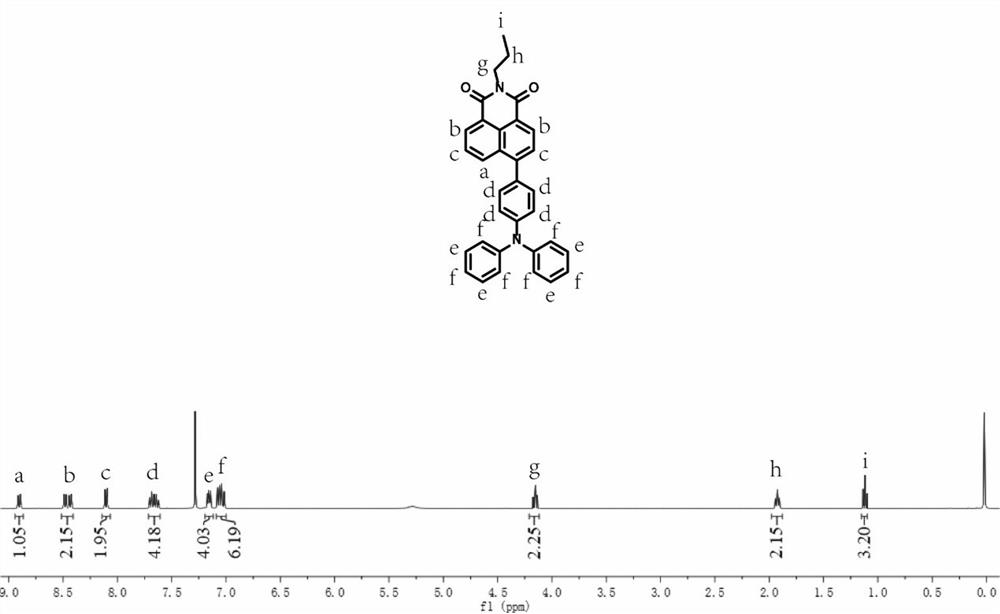A rotor-type fluorescent molecule for detecting starch gelatinization degree and its preparation and application
A fluorescent molecule, starch gelatinization technology, applied in fluorescence/phosphorescence, chemical instruments and methods, material analysis by optical means, etc. The process is complicated and other problems, to achieve the effect of low cost, conducive to large-scale production and further commercial promotion, long-term storage and subsequent use
- Summary
- Abstract
- Description
- Claims
- Application Information
AI Technical Summary
Problems solved by technology
Method used
Image
Examples
Embodiment 1
[0046] Preparation method of rotor-type fluorescent molecules for starch gelatinization detection, comprising the following steps:
[0047] (1) Dissolve 59 mg of n-propylamine in ethanol, stir evenly, control the concentration of n-propylamine to 1 M, to give solution 1;
[0048] (2) 441 mg of 6-(4-(diphenylamine)-1H,3H-benzo[de] isotene-1,3-dione dissolved in ethanol, ultrasonic stirring evenly, control 6-(4-(diphenylamine)-1H, 3H-benzo[de] isotene-1,3-dione concentration of 1M, to give solution 2;
[0049] (3) Add 100 mg of calcium carbonate in solution 2, and then fill the reaction system with nitrogen, heat the reaction to 78 ° C, add the solution 1 to the reaction system drop by drop, the reaction is 48 h, after the reaction is over, the crude product is added dropwise ethyl acetate ultrasonic shock uniformly, and then add deionized water in it dropwise, ultrasonic vibration, and then extract through the separating funnel to take the organic phase; the organic phase is used a...
Embodiment 2
[0054] Preparation method of rotor-type fluorescent molecules for starch gelatinization detection, comprising the following steps:
[0055] (1) Dissolve 295 mg of n-propylamine in ethanol, stir evenly, control the concentration of n-propylamine to 25 M, and give solution 1;
[0056] (2) 441 mg of 6-(4-(diphenylamine)-1H,3H-benzo[de] isotene-1,3-dione dissolved in ethanol, ultrasonic stirring evenly, control 6-(4-(diphenylamine)-1H,3H-benzo[de] isotene-1,3-dione concentration of 5M, to give solution 2;
[0057] (3) Add 1200 mg of calcium carbonate in solution 2, and then fill the reaction system with nitrogen, heat the reaction to 56 ° C, add the solution drop by drop to the reaction system, the reaction is 24 h, after the reaction is over, the crude product is added dropwise ethyl acetate ultrasonic vibration uniformly, and then add deionized water in it dropwise, ultrasonic vibration, and then extract through the separating funnel to take the organic phase; the organic phase is u...
Embodiment 3
[0060] Preparation method of rotor-type fluorescent molecules for starch gelatinization detection, comprising the following steps:
[0061] (1) Dissolve 590 mg of n-propylamine in ethanol, stir evenly, control the concentration of n-propylamine to 50 M, to give solution 1;
[0062] (2) 441 mg of 6-(4-(diphenylamine)-1H,3H-benzo[de] isotene-1,3-dione dissolved in ethanol, ultrasonic stirring evenly, control 6-(4-(diphenylamine)-1H, 3H-benzo[de] isotene-1,3-dione concentration of 10 M, to give solution 2;
[0063] (3) Add 2500 mg of calcium carbonate in solution 2, and then fill the reaction system with nitrogen, heat the reaction to 30 ° C, add the solution drop by drop to the reaction system, the reaction is 1 h, after the reaction is over, the crude product is added dropwise ethyl acetate ultrasonic shock uniformly, and then add deionized water in it dropwise, ultrasonic vibration, and then extract through the dispensing funnel to take the organic phase; the organic phase is used ...
PUM
| Property | Measurement | Unit |
|---|---|---|
| emission peak | aaaaa | aaaaa |
Abstract
Description
Claims
Application Information
 Login to View More
Login to View More - R&D
- Intellectual Property
- Life Sciences
- Materials
- Tech Scout
- Unparalleled Data Quality
- Higher Quality Content
- 60% Fewer Hallucinations
Browse by: Latest US Patents, China's latest patents, Technical Efficacy Thesaurus, Application Domain, Technology Topic, Popular Technical Reports.
© 2025 PatSnap. All rights reserved.Legal|Privacy policy|Modern Slavery Act Transparency Statement|Sitemap|About US| Contact US: help@patsnap.com



